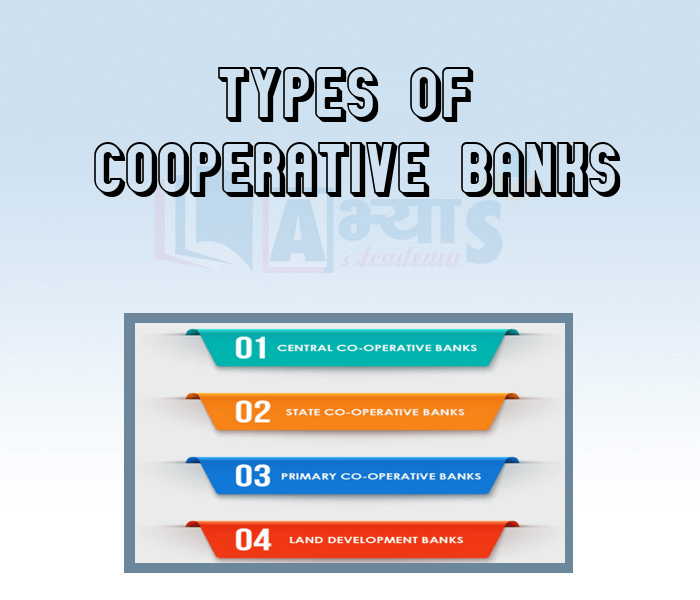Types Of Cooperative Banks










Types Of Co-operative Banks
There are three types of co-operative banks operating in our country. They are primary credit societies, central co - operative banks and state co - operative banks. These bank are organized at three levels. village or town level, district level and state level.
State Co-operative Banks:
These are the apex (highest level) co-operative banks in all the states of the country. They mobilise funds and help in its proper channelisation among various sectors, The money reaches the individual borrowers from the state co-operative banks through the central co-operative banks and the primary credit societies
Central Co-operative Banks:
These banks operate at the district level having some of the primary credit societies belonging to the same district as the members. These banks provide loans to their members (i.e., primary credit societies) and function as a link between primary credit societies and state co-operative banks.
Primary Credit Societies:
These are formed at the village or town level with borrower and non-borrower members residing in one locality. The operations of each society are restricted to a small area so that the members know each other and are able to watch over the activities of all members to prevent frauds.
Specialised Banks:
There are some banks, which cater to the requirements and provide overall support for setting up business in specific areas of activity. EXIM Bank, SIDBI and NABARD are examples of such banks. They engage themselves in some specific area or activity and thus, are called specialised banks. Let us know about them.
Export Import Bank of India (EXIM Bank):
EXIM Bank was established in year 1982. If you want to set up a business for exporting products abroad or importing products from foreign countries tor sale in our country. EXIM bank can provide you the required support and assistance. The bank grants loans to exporters and importers and also provides information about the international market. It gives guidance about the opportunities for export or import, the risks involved in it and the competition to be faced, etc.
Small Industries Development Bank of India (SIDBI):
SIDBI was established on the year April, 1990. It provides loan on easy terms to small scale business unites or industry including the newly established. It also finances modernisation of small - scale industrial units, use of new technology and market activities. The aim and focus of SIDBI is to promote, finance and develop small-scale industries.
National Bank for Agriculture and Rural Development (NABARD):
NABARD was established on 12h July, 1982. It is a central or apex institution for financing agricultural and rural sectors. It a person is engaged in agriculture or other activities like handloom weaving, fishing, etc. NABARD can provide credit. both short - term and long - term, through regional rural banks. It provides financial assistance. especially. to co-operative credit, in the field of agriculture, small - scale industries, cottage and village industries handicrafts and allied economic activities in rural areas.
Functions and Roles of NABARD -
Students / Parents Reviews [10]
It was good as the experience because as we had come here we had been improved in a such envirnment created here.Extra is taught which is beneficial for future.

Eshan Arora
8thIt has a great methodology. Students here can get analysis to their test quickly.We can learn easily through PPTs and the testing methods are good. We know that where we have to practice

Barkha Arora
10thOne of the best institutes to develope a child interest in studies.Provides SST and English knowledge also unlike other institutes. Teachers are co operative and friendly online tests andPPT develope practical knowledge also.

Aman Kumar Shrivastava
10thAbhyas is a complete education Institute. Here extreme care is taken by teacher with the help of regular exam. Extra classes also conducted by the institute, if the student is weak.

Om Umang
10thBeing a parent, I saw my daughter improvement in her studies by seeing a good result in all day to day compititive exam TMO, NSO, IEO etc and as well as studies. I have got a fruitful result from my daughter.

Prisha Gupta
8thAbhyas Methodology is very good. It is based on according to student and each child manages accordingly to its properly. Methodology has improved the abilities of students to shine them in future.

Manish Kumar
10thAbout Abhyas metholodology the teachers are very nice and hardworking toward students.The Centre Head Mrs Anu Sethi is also a brilliant teacher.Abhyas has taught me how to overcome problems and has always taken my doubts and suppoeted me.

Shreya Shrivastava
8thMy experience with Abhyas academy is very good. I did not think that my every subject coming here will be so strong. The main thing is that the online tests had made me learn here more things.

Hiya Gupta
8thA marvelous experience with Abhyas. I am glad to share that my ward has achieved more than enough at the Ambala ABHYAS centre. Years have passed on and more and more he has gained. May the centre flourish and develop day by day by the grace of God.

Archit Segal
7thI have spent a wonderful time in Abhyas academy. It has made my reasoning more apt, English more stronger and Maths an interesting subject for me. It has given me a habbit of self studying
